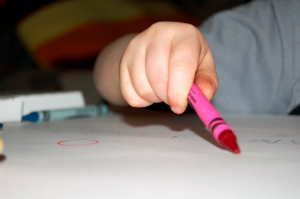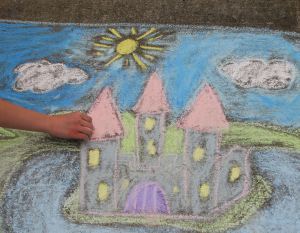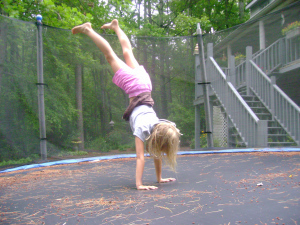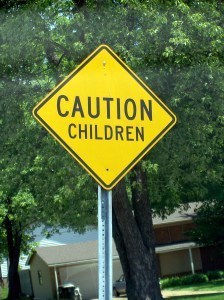Jeni Hooper's Blog, page 3
March 24, 2015
Play has a purpose: why the focus on early academics is not what our children need.
A new baseline assessment is being introduced into schools to assess children’s early literacy and numeracy skills objectively. Teachers will also be asked to assess personal and social development from their initial observations. The broader and more detailed assessments which currently result from the EYFS profile has been ruled out as not focusing on the academics sufficiently to provide the baseline for comparison with Key Stage 1 SATS . We’ve had baseline assessments before, nearly 20 years ago now, which were dropped after a few years for being unworkable. The reason for this re- introduction is the government’s preoccupation with school’s accountability, they want to know whether each school doing enough to help children become literate and numerate.
 Their assumption is that if you measure something it will be both accurate and useful. This may work if you are measuring a wall with a yardstick but children defy this simple process by being much more complex and variable from day to day especially when they are 4. Child Psychology is adamant that early assessment doesn’t stand up to scrutiny, either for its reliability (getting the same result each time ) or its validity (predicting future outcomes) So it won’t even do what they want it to but my concerns today are broader concerning what these demands will do to early education. There is a strong expectation that practitioners should move away from play based learning into structured activities which have a literacy or numeracy focus. This is not what the early year’s sector wants to do and most will resist this pressure but many parents may be confused by the mixed messages they receive.
Their assumption is that if you measure something it will be both accurate and useful. This may work if you are measuring a wall with a yardstick but children defy this simple process by being much more complex and variable from day to day especially when they are 4. Child Psychology is adamant that early assessment doesn’t stand up to scrutiny, either for its reliability (getting the same result each time ) or its validity (predicting future outcomes) So it won’t even do what they want it to but my concerns today are broader concerning what these demands will do to early education. There is a strong expectation that practitioners should move away from play based learning into structured activities which have a literacy or numeracy focus. This is not what the early year’s sector wants to do and most will resist this pressure but many parents may be confused by the mixed messages they receive.
We need to speak up for play and broaden our understanding away from the Oxford Dictionary definition:
Engage in activity for enjoyment and recreation rather than a serious or practical purpose.
“The children were playing by a pool”
synonyms:
amuse oneself, entertain oneself, enjoy oneself, have fun, have a good time, be at leisure, occupy oneself, divert oneself, play games,
It is more accurate to understand play as purposeful and part of the child’s inner drive for knowledge and development. Children learn through play, but what is equally important: through play children learn how to learn. As 16th century French writer and philosopher, Michel de Montaigne, said: “Children at play are not playing about. Their games should be seen as their most serious minded activity.”
 Small children are not passive, inert receivers of adult wisdom, they have a mind of their own and the best parenting and early year’s education works with that natural curiousity and drive to build a child’s knowledge and experience of the world. Play has a purpose, each child wants to engage in the world around them and the more child friendly and stimulating the adults make it the more learning will result. Play is stifled when the adult is unresponsive or the environment is restrictive and unchanging.
Small children are not passive, inert receivers of adult wisdom, they have a mind of their own and the best parenting and early year’s education works with that natural curiousity and drive to build a child’s knowledge and experience of the world. Play has a purpose, each child wants to engage in the world around them and the more child friendly and stimulating the adults make it the more learning will result. Play is stifled when the adult is unresponsive or the environment is restrictive and unchanging.
Children are under increasing pressure to begin their formal education as early as possible. The emphasis on getting young children reading and learning maths is putting time for play under pressure. We need to be confident of the reasons why play is important for a child’s healthy, happy development if we are to protect the vital character of early year’s provision.
What does play contribute to a child’s development? Children have a powerful desire to play which ensures the child is avidly curious to learn about the world. Play helps children to notice their surroundings and make sense of what they experience. Play is not just a way of passing time; it is special for 10 important reasons.
Play feeds a child’s curiousity and ensures the brain thrives on gaining knowledge. A child has a mind of their own from the beginning and sets out to learn more about themselves and the world around them. Play is what happens when a child follows their own line of reasoning to see where it takes them. Small children are mini scientists exploring and testing out what they find. They ask questions and make judgments. “What is this?” “What can it do?|” “How is it like other objects I know about?” “How is it different?” If we look at the lives of scientists, inventors, and artists we see that playful experimentation is what “creates” their major breakthroughs.
Play develops language and communication. Children learn the language they need. A busy child at play will share what they are doing with an adult by commenting and asking questions which have a powerful relevance to what they are doing. The concept of sustained shared thinking acknowledges the importance of starting from the child and allowing their needs and their world view to shape the dialogue between adult and child. This builds the child’s confidence as well as developing knowledge. When adults ask questions or attempt to teach new concepts a child soon loses interest if it doesn’t resonate with what they are doing. When you observe this you can see the child’s unease and anxiety at being taken out of their comfort zone.
Play is fun and makes us happy: when you think back to your early childhood what are your treasured memories? Maybe you remember a special toy fondly or the time you went on an adventure in the woods or built a den. Children value their achievements. What makes a child feel competent is what they learn to do for themselves. That’s why children want to keep models they’ve made or have their art displayed at home.
Play reduces stress by helping children feel comfortable and in control. “I can do what I want and need to do” Children typically have much less freedom than a generation ago which makes them tense. I believe that some of the rise in behaviour problems is linked to this limited opportunity to gain satisfaction and achievement through play.
Play helps children discover their strengths: children are attracted to activities they can soon learn to do successfully. Once one level is mastered they move onto the next challenge. Play gives a child the freedom to experiment and discover what works well for them, what skills they have and what they can make happen. Playing to your strengths not only builds a child’s competence but creates confidence and excitement at the prospect of learning something new.
 Play makes practice fun: if you have something to learn you need to rehearse it and repeat important steps many, many times for the skill to develop. Play is the perfect system for practicing developing skills whether it is learning to climb or becoming a more skilful communicator. Watch how happy children are to repeat things which interest them. This experience of playful practice helps children to recognise and accept the importance of practice in other areas of learning once they get to school.
Play makes practice fun: if you have something to learn you need to rehearse it and repeat important steps many, many times for the skill to develop. Play is the perfect system for practicing developing skills whether it is learning to climb or becoming a more skilful communicator. Watch how happy children are to repeat things which interest them. This experience of playful practice helps children to recognise and accept the importance of practice in other areas of learning once they get to school.Play builds a child’s ability to concentrate. Play is exciting and absorbing and results in deep concentration for the young child. Learning to concentrate emerges from play as a pleasant side effect. Young children are designed to concentrate on what interests them and find it more difficult to concentrate on something led by an adult. A child’s concentration span increases the more experience they have of deeply absorbing play. Learning to shut out distractions is an important part of this. When a child has restricted opportunities for uninterrupted play this has a direct effect on their ability to control their attention.
Play teaches organisation skills. Play may start with a spontaneous idea, but it quickly becomes planned and self-managing. “What shall I do now?” “Where shall I take this next?” Psychologists call this ability to plan and oversee a work in progress Executive Function. As a child’s brain develops, this skill becomes more established. This vital cognitive skill is the foundation for effective learning. Children who have well developed executive function will be successful in education. The Plan, Do, Review process is designed to reinforce this developing skill.
Play helps a child become self-motivated which is vitally important as children make their way through school. Teachers can’t oversee every detail of a child’s work. Children who have experience of successful learning through play will become more active learners who are not passively dependent on adults overseeing every learning moment. This belief in their competence to learn will transfer to classroom learning.
 Play nurtures creativity which is using what is available in the room or in your head to make something new out of the familiar. The imagination is not just a pleasant place to visit; it is where all discoveries, inventions and new ideas are incubated. Creativity is seeing the world in a new and different way. Play is the ideal apprenticeship for creativity. The danger for children who are over scheduled with little free time is that it saps creativity. The areas of the brain which manages reflection and imagination are switched off when we are engaged with a demanding task. The imagination needs space to work its magic. That’s why our best ideas pop into our heads on a walk or in the bath. If we over schedule children they don’t have time to dream.
Play nurtures creativity which is using what is available in the room or in your head to make something new out of the familiar. The imagination is not just a pleasant place to visit; it is where all discoveries, inventions and new ideas are incubated. Creativity is seeing the world in a new and different way. Play is the ideal apprenticeship for creativity. The danger for children who are over scheduled with little free time is that it saps creativity. The areas of the brain which manages reflection and imagination are switched off when we are engaged with a demanding task. The imagination needs space to work its magic. That’s why our best ideas pop into our heads on a walk or in the bath. If we over schedule children they don’t have time to dream.
Jeni Hooper is an Educational and Child Psychologist with a special interest in positive psychology. She is the author of What Children Need to be Happy, Confident and Successful which offers parents and teachers a step by step guide to creating a happy childhood. Jeni works with schools, local authorities and the voluntary sector as a consultant,

March 21, 2015
School holidays: how children learn even when they appear to be playing.
Will your children have a happy Easter break doing things they love and avoiding boredom? Are you confident that things will go well or do you wonder what to do for the best? Is this a time for rest and recreation or can children have a valuable and fulfilling time while still having fun?

Children have few opportunities in term time to choose how they spend their time and the danger is that they become used to adults setting the agenda and supervising them. Freedom is exciting but also a responsibility that children have to learn how to handle. Older generations may tell you how in their day they went out after breakfast and only came home for meals. Times have changed and few children now have that freedom to roam and to learn how to use their time well. How can you help your child learn to be busy and enjoy what they are doing?
One possibility is to explore The National Trust’s 50 things to do before 11 3/4 which offers a range of exciting outdoor activities. Children can enjoy searching out these activities and ticking them off their adventure list. But for lasting impact children need to discover those skills and experiences they want to return to again and again. Those repeated experiences tend to tap into a child’s strengths and provide lasting satisfaction.
 One of positive psychology’s recent contributions to our understanding of wellbeing is Flow. Flow defines a state in which a person is truly engaged in and fulfilled by what they are doing. They are completely absorbed and time just flies past. You are more likely to experience flow when you engage in an activity which has enough challenge to stretch you but where you also have the confidence in your skills to succeed.
One of positive psychology’s recent contributions to our understanding of wellbeing is Flow. Flow defines a state in which a person is truly engaged in and fulfilled by what they are doing. They are completely absorbed and time just flies past. You are more likely to experience flow when you engage in an activity which has enough challenge to stretch you but where you also have the confidence in your skills to succeed.
One solution to making the school holidays fulfilling and avoiding boredom is to discover what your child can do which creates flow. How can they spend their time with things that really engage them?
For many children that involves finding activities that use their chosen talents and interests. When children already know what they enjoy they just need the opportunity to get involved with something that is meaningful to them. Younger children will need some help to discover what suits them. Art, dance, sport and drama are strong contenders for creating flow. As long as a child has some freedom to choose how they interpret the activity creatively there is a strong possibility they will enjoy it more and experience flow.
What do you look out for to show when flow might happen? Here are 7 signs that flow is likely
1) There are clear goals which give your child something to aim for
2) Your child has the skills needed to meet the demands of the activity.
3) Your child feels confident and in control regarding the situation and the outcome.
4) The activity requires concentration and focus.
5) The activity is intrinsically rewarding; that is, your child wants to do it for their own satisfaction rather than to please others. .
6) The activity is quietly absorbing, your feelings of self-consciousness, worry, or the frustrations of everyday life are pushed aside.
7) Sense of time is altered; hours may seem to pass by in minutes, or minutes can seem like hours.
Your child doesn’t have to be an athlete or an artist to experience flow. Flow experiences are attainable by most anyone.
Consider for yourself those activities that transport you to a place beyond your day-to-day concerns and feelings. What absorbs your attention? Is it cooking a new recipe? Reading a book with your child? Solving the Sunday morning crossword puzzle? Going for a long cycle ride? Working in the garden? Some people experience flow at work but others don’t, it all depends on how well your job fits with your passions.
A happy and fulfilled life comes from within, knowing your personal strengths and how to use them, rather than from a hedonistic and pleasure seeking life. Life satisfaction and wellbeing stem from a sense of purpose and meaning: what do I love to do, what matters to me? This is deeper and more lasting than a pleasure seeking life.
Helping children to find that personal sense of meaning and purpose may sound like a tall order but getting started is really quite simple and a lot of fun. We can’t control what life will bring but we can help young people to be ready to give their best.
So where will you start? Watching and talking to your child about what they love is a good start. Have fun and enjoy the journey.

December 31, 2014
Creating a happy, secure and empowering childhood: 5 wishes for 2015
The turn of the year is traditionally a time for reflection and for considering self-improvement. Instead I have been thinking about what would make the biggest difference for children in our care. I wish you all a happy and fulfilling 2015.
1) Start from the child.
Each child has within them the adult they could become. This small flame at first glows and then catches fire with nurture and empathic support. No child can go it alone. Neither can their true self emerge and grow if the world about them doesn’t see who they are. Who is this young person? What are their strengths, their desires and their needs? What is their unique personality and what brings out the best in them?
In my ideal world every adult will take the time to stand back and observe the child in front of them whether they are part of your family, your school or your community. These observations and soul searching will inform what you do and make any parent manual or curriculum scheme merely a framework not a blueprint.
2) End the race through childhood
The tendency to assume that earlier is better is not new. The Hurried Child by David Elkind 2001 eloquently explored the psychological harm of wanting too much too soon. Too Much Too Soon is now a phrase often used to sum up concerns for both competitive parenting and accelerated early years and school curriculum schemes.
Childhood is not an inconvenient phase of life which needs to be rushed. The force feeding of accelerated programmes misses the essence of childhood, which is that the child needs time to immerse themselves in life’s experiences and assimilate and apply that knowledge. Psychologists from Piaget onward have been documenting the child’s key role in learning, when we rush on we risk leaving the child behind. Too much too soon doesn’t necessarily build lasting skills or knowledge and equally importantly it risks creating huge emotional insecurity with long term harm to mental health. Anxiety, sleeping difficulties, challenging behaviour all are signs that a child is not coping with what life expects from them.
3) 5 a day for wellbeing
We hear more about the importance of fruit and veg for our physical health than we do about the factors which protect our mental health and help create wellbeing.
5 a day for wellbeing was devised by The New Economics Foundation which researches a “new model of wealth creation, based on equality, diversity and economic stability”. How the economy impacts on wellbeing is core to their work.
Connect: first of all other people matter, children want to spend quality time with the people they care about with family, friends, and neighbours. These relationships are the cornerstones of a happy life and need time to develop and nurture. Building these connections will support and enrich a child’s life. In a busy world the time for love and friendships need to be protected from the intrusion of work/school, travel, shopping/cleaning, and homework.
Be active: an active life is good for both physical health and for emotional wellbeing as moderate exercise releases endorphins. Children need an hour a day of activity which makes them slightly breathless. Exercising makes you feel good so help children discover a range of physical activities they enjoy so they can do something every day.
Take notice: encourage children to notice, appreciate and be mindful of all experience. Encourage curiousity, asking questions and appreciating the world around them. “What is that?” “How does that work?” Catch sight of the beautiful. Remark on the unusual. Reflecting on experiences will help a child appreciate what matters to them.
Value learning: for children learning can become a chore or something that is unending. When a child doesn’t get the chance to stop and appreciate what they have learnt so far it can undermine their confidence, all they see are the tasks ahead. It’s vital to celebrate achievements large and small. Focus on the CAN DO List rather than the TO DO list.
Give: children love to get involved with things and make a contribution. It is fundamental to being human to take care of others but sometimes we see children as not being capable and restrict the ways they can contribute. Giving teaches children about the world around them. Seeing yourself, and your happiness, linked to the wider community can be incredibly rewarding and creates connections with the people around you.
4) A new understanding of play
In recent years available time for independent play has been squeezed. Previous generations had more free time, less adult supervision and were allowed to be outside with friends in the local neighbourhood. Now safety concerns and parent work patterns increase the likelihood of children being in childcare after school or indoors. In tandem with this social shift the importance of play in child development has been side-lined to suit these patterns of adult led leisure time for children. We want to believe that this is good for children as well as convenient for adults but the evidence for the importance of play is powerful.
The early year’s profession have advocated the importance of play in child development but have been shouting into the winds of change led by those who want to make literacy and numeracy the priority. The chasms of misunderstanding are vast. Those who wish to see more time spent developing literacy assume it merely needs more teaching time. Those who value play point out that a child’s development emerges from formative experiences in self-managed play. I summarised the key points here
Playfulness and independence of mind is the engine house of creativity and the need to play doesn’t end when children start school. Not only do the arts derive from a vivid imagination but also STEM subjects require the ability to solve old problems by reframing the questions to research. Play is thinking outside the box, no set rules, no constraints. Children who miss out on this aspect of independence of mind can only ever be followers to someone else’s tune.
5) Working with strengths
Strengths are the activities, relationships and ways of learning that energize people. They are the inner qualities that make us feel most alive and because of that, they are the places where we have the potential to make our most meaningful contributions to life. Strengths are different to interests because strengths are innate and children will be drawn to them for their entire lives, while interests may be fleeting.
Working with a child’s strengths is often overlooked on the assumption that education is about teaching and developing what is as yet unknown. Strengths are seen as an incidental asset rather than a potential foundation for effective teaching. Encouraging children to approach a task with a personalised focus is likely to increase engagement. Working with strengths automatically shifts things up a gear to give the child more autonomy and investment in choosing how to apply their strengths to a task. Working with strengths brings freedom and autonomy and encourages self-knowledge and reflection on what matters to you. While not every task will tap into strengths the experience of being immersed in tasks which play to strengths is an important formative experience which aids subject choices and career decisions.
At the heart of these 5 wishes is the concept of trust. Trust that your intuition will recognise what a child needs and most of all a trust in the child’s ability to take that journey through childhood and learn best from it when adults are sympathetic supporters rather than dictatorial leaders.
Jeni Hooper is a Child and Educational Psychologist specialising in helping children to find their best selves and to flourish. Her book What Children need to be Happy, Confident and Successful: Step by Step Positive Psychology to Help Children Flourish is published by Jessica Kingsley Publishers and can be viewed here http://www.amazon.co.uk/What-Children-Happy-Confident-Successful/dp/1849052395/ref=tmm_pap_title_0
Jeni can be contacted at info@jenihooper.com or visit my website www.jenihooper.com

December 23, 2014
Don’t Let Stress Spoil your family’s Christmas.
Christmas is a magical time of year but it can also be rather stressful. Modern life is fast and highly stimulating, we are bombarded by information and are tempted by endless opportunities which create increasingly high expectations of what we should do and achieve. Many adults thrive on this adrenaline-high lifestyle. But have you noticed how many children are far from happy?
 A happy, healthy child is busy, energetic, and carefree. In contrast many children now have intense episodes of panic, prolonged bouts of tearfulness, frequent nightmares, fears of being left alone and extreme temper tantrums.
A happy, healthy child is busy, energetic, and carefree. In contrast many children now have intense episodes of panic, prolonged bouts of tearfulness, frequent nightmares, fears of being left alone and extreme temper tantrums.
Your grandmother may believe that modern kids are spoilt, have too many material goods and have become self centred. But there is another explanation. Modern life can be too stressful for children. The reason why is linked to their hyper sensitive reactions to stress.
Children have the most brilliant built in survival systems which are more finely tuned than the adult’s alert system. This makes evolutionary sense because children are more vulnerable. Nature protects children by making them ultra sensitive to any possible threats or dangers. In simple terms, the child’s body and brain are more finely tuned to automatically detect possible dangers. Immediately there is a surge of adrenaline and cortisol which is needed to create the flight or fight reaction.
 However children cannot protect themselves so their reaction includes extreme emotional reactions guaranteed to attract their parents’ protection. Now these automatic alarm systems are rather primitive so don’t know real danger from false. They are designed to be fast rather than accurate. They work by detecting either external signs of danger or by reading increased internal signs of stress from raised heart rate and breathing which has not been caused by exertion. If your heart rate and breathing increase, so the brain reasons, there must be something going on.
However children cannot protect themselves so their reaction includes extreme emotional reactions guaranteed to attract their parents’ protection. Now these automatic alarm systems are rather primitive so don’t know real danger from false. They are designed to be fast rather than accurate. They work by detecting either external signs of danger or by reading increased internal signs of stress from raised heart rate and breathing which has not been caused by exertion. If your heart rate and breathing increase, so the brain reasons, there must be something going on.
For the 21st century child these internal stress reactions are more likely to be due to being bombarded by noise, having too much to do or being rushed from place to place by an adult in hurry. Raised expectations at school, too much homework, not enough time to play all raise stress levels. All contribute to a speeded up life which increases heart rate and speeds up breathing which results in increasing meltdown.
 So what can we do? Not everyone can, or wants to downshift, move to the country and weave their own cloth. If the credit crunch has added more, not less pressure to your life here are some of your options.
So what can we do? Not everyone can, or wants to downshift, move to the country and weave their own cloth. If the credit crunch has added more, not less pressure to your life here are some of your options.
1) Build up the pleasure to pain ratio
Research from positive psychology has found a ratio of 3:1 is the tipping point for well being. You don’t even have to create endless good times, you can increase your ratio by creating good memories to draw on and by slowly and deliberately anticipating and savouring something special that is still in the future. So when the present is dull and routine you can revisit the past or imagine the future with equally good results for your well being.
2) Find time to slow down
Children can benefit from as little as 5 minutes a day deliberately focused on slowing down the breathing and heart rate to create a calm but alert state of mind. More is better, but learning the skill will allow a child to repeat this for themselves when needed. Yoga or other slow exercise which concentrates the mind works well as does slow breathing techniques (breathing in and out to a slow count of 4 from 5 to 10 times is effective). Some schools are experimenting with child friendly forms of meditation which not only calm emotions but also improve concentration and learning. A stressed child does not learn effectively as both concentration and memory are adversely affected by stress.
On the home front, a slow, warm bath and a bedtime story are also very calming and help promote deep sleep which is restorative.
3) Turn taking and sharing
Family occasions where we wait and listen to others, not only calm us, but also help our bodies to entrain to each other. Entrainment is a biological process whereby we become in tune with others who we support and depend on, this process is often lost when we all do our own thing, and only meet up occasionally, despite being in the same house. Being in tune with others makes children feel safe and protected.
4) Create a treasure Chest
Building memories to draw upon creates precious moments that can be savoured again and again. Give your child a special box to collect photos, drawings, tickets from days out, postcards, small objects and anything else which will trigger intense pleasure when recalling a past event. Look at these treasures together to recall happy times when your child needs their spirits lifted.
Being under pressure and being judged for your achievements is a commonplace of modern childhood. Childhood is no longer a time of innocence and freedom to explore and grow at your own pace. Many children are now on a fast track timetable to accelerate achievement. Sadly this often backfires.
Instead offer your child the gift of appreciation, to acknowledge who they are now, and to signal your belief in their potential. Your observations and comments in recognising their true selves will show your appreciation and acceptance which will fortify them through tough times. A golden seed is true recognition from others which creates faith and optimism for the future. Tell them what you see rather than what you wish for.
Lastly be alert to your child’s expression of the uncomfortable emotions of fear, anger and distress, they are there as a warning that all is not well. These emotions can be triggered by a lifestyle which is not in reality threatening or dangerous but is stressful or too fast and too busy. Children run on slow time. You don’t have to totally change your life but do try small steady changes. Decide what the smallest thing is that you can start today that will create the biggest difference to your life.
Jeni Hooper is a Child and Educational Psychologist specialising in helping children to find their best selves and to flourish. Her book What Children need to be Happy, Confident and Successful: Step by Step Positive Psychology to Help Children Flourish is published by Jessica Kingsley Publishers and can be viewed here http://www.amazon.co.uk/What-Children-Happy-Confident-Successful/dp/1849052395/ref=tmm_pap_title_0
Jeni can be contacted at info@jenihooper.com or visit my website www.jenihooper.com

Have a Magical Christmas without Guilt.
Christmas Myths and Magic
Do you believe in Father Christmas? Will he be coming down your chimney while his reindeer hover overhead? Is his sleigh full of toys going to the next house which has good boys and girls tucked up in their beds? Do you have special food which must be left out for him? Can he only get to your house when you send him your list of special presents?
 If you just want to revel in the magic of Christmas and see the delight on your children’s faces then I wish you a truly wonderful time. I sincerely hope it is many years before your children start to question the Christmas stories. However, if you are someone who feels mildly uncomfortable at creating myths to deceive your children because it makes this time of year very special then read on. They may be myths but they create a very special magic.
If you just want to revel in the magic of Christmas and see the delight on your children’s faces then I wish you a truly wonderful time. I sincerely hope it is many years before your children start to question the Christmas stories. However, if you are someone who feels mildly uncomfortable at creating myths to deceive your children because it makes this time of year very special then read on. They may be myths but they create a very special magic.
Magical stories boost our wellbeing. In recent years positive psychology has researched what makes a real difference to wellbeing and what you can do to boost the feel good factor. Looking at Christmas from this perspective helps us to understand why we do what we do.
 Human beings have always told stories, especially when people get together in the cold and the dark wanting to feel safe, cherished and full of hope. Our ancestors used stories which made their families feel special, stories of magic which transformed disaster to triumph or which brought unexpected great fortune. Christmas comes just as that dark and dreary time of year begins and the magic it creates lifts our spirits. What’s not to like?
Human beings have always told stories, especially when people get together in the cold and the dark wanting to feel safe, cherished and full of hope. Our ancestors used stories which made their families feel special, stories of magic which transformed disaster to triumph or which brought unexpected great fortune. Christmas comes just as that dark and dreary time of year begins and the magic it creates lifts our spirits. What’s not to like?
The power of a good story is something more than just the feel good factor we get straight away; it has the power to transform lives over a much longer period. Behind every good story is a profound message which resonates deep inside us. As a Child Psychologist and Wellbeing Coach I know the therapeutic power of stories. There are stories that can help children cope with grief and loss or can transform agonising anger or fear into the seeds of a happier life. Children’s emotions are powerful and not yet moderated by the rational, thinking brain which helps us to find solutions in adult life. Stories talk to the emotional brain and help children to learn important skills and deal with disappointment and difficult emotions.
 Now back to Christmas. The weather is cold, but not delightfully so, in a snowy sort of way. It can be gray, boring and rather dull. That can be tough on our energy and our spirits. The Autumn Term at school has been long and hard and probably there is a new teacher to get to know. Your child may now be tired and easily upset. As the nights draw in, the opportunities to go out and let off steam reduce so there is spare energy which easily flips over into frustration. Then along comes Christmas with sparkly light and the promise of special treats all round. What a difference it makes. So how can we make the most of the benefits without everyone becoming stressed or over excited? So what can you weave into the magic mix for best effect?
Now back to Christmas. The weather is cold, but not delightfully so, in a snowy sort of way. It can be gray, boring and rather dull. That can be tough on our energy and our spirits. The Autumn Term at school has been long and hard and probably there is a new teacher to get to know. Your child may now be tired and easily upset. As the nights draw in, the opportunities to go out and let off steam reduce so there is spare energy which easily flips over into frustration. Then along comes Christmas with sparkly light and the promise of special treats all round. What a difference it makes. So how can we make the most of the benefits without everyone becoming stressed or over excited? So what can you weave into the magic mix for best effect?
Build the anticipation
Looking forward to something gives us pleasure. We take things slowly, savouring small pleasures like the advent calendar. One little chap I know got up at midnight on the first day so he could open the window on his advent calendar. That’s how special it was for him.
Knowing it is going to happen makes children feel, safe, loved and secure. Family rituals create special moments for each day which are the stepping stones along the way to help children manage the wait. Incidentally, learning to wait for something special is strongly linked to success in life probably because you learn self control and how to plan for the future.
Create a Christmas Count Down
If you don’t go in for advent calendars, then maybe you can create your own count down for the remaining days with pictures or photos of what you are doing. How lovely to have a record of everyone decorating the tree, wrapping presents, writing cards, visiting friends, or going to sing carols. Pictures capture the memories, but also help us to focus on the positives of the run up to Christmas rather than obsessing greedily on what you are hoping to be given.
Enjoy each day as it comes
Some people say that Christmas is just one day of the year so why all the fuss? But when we expand the festive season positively and deliberately, the emotional and spiritual impact means so much more. You don’t have to be religious to value everything that goes with Christmas because the theme is about giving and hope which transcends all barriers of religion and culture.
Focus on giving not receiving
The recent TV ad, you know the one, where the little boy can’t wait to see the joy on his parents’ faces may be intended as a sentimental joke but children love to give if they are helped to do so. Hand-made or small and carefully chosen gifts give real pleasure to both giver and receiver. Thinking of what someone will love to receive and then being thanked for your care and thoughtfulness is a profound pleasure which no amount of material bling can overshadow. In contrast receiving presents can be over in a flash and some small children rip off the paper in a rush and then loose interest in most of what they have been given. Taking time and sharing is a deeper and more lasting pleasure.
There are many charities and community projects which provide for those who are in need of support. Families which have a tradition of giving gifts to those in need find it reminds them they have much to be grateful for. Some families buy new gifts, while others pass on well loved and cared for toys so that another child can enjoy playing with something that has been special to them.
Find time for gratitude and appreciation
How can you help young children to see that Christmas is not just about receiving gifts? The things you do together are on the day are part of the celebration of family and friends. What you eat, the games you play and even special films or TV programmes become part of the shared memory. There is something special about taking turns to open gifts so it is a shared experience. Small children may be impatient at first but making the experience last adds to the fun. Taking care to thank the giver and comment positively on what you have received expresses your gratitude for the care and thought that a gift represents. When children write thank you letters they include people in their thoughts who do not share Christmas with you. When something on a child’s wish list does not arrive, you can help your child to focus on what they do have and how that will add to their pleasure. Managing disappointment is a valuable life skill which will bring much more happiness and wellbeing in the long term than being spoilt and indulged can ever deliver.
Christmas may only be one day a year but it can add something special to wellbeing across the entire year.
I wish you all a truly happy and memorable Christmas and a Happy New Year 2015.

November 26, 2014
Creating confident learners: is a growth mindset enough?
The advantages of a Growth Mindset are well known and many schools now have an active Growth Mindset policy. Growth Mindset is a brilliant and deceptively simple concept based on Carol Dweck’s research. She has identified that learning is more effective when we believe that diligence, hard work and careful practice underpin success rather than assuming that ability is the deciding factor. A self-evident truth you might say but sustaining a Growth Mindset is not so easy. Many children struggle to stay with this set of values and despite believing in the value of hard work do find it difficult to sustain. This may not be because they have reverted to a fixed mindset where they assume that their lack of ability is causing them to struggle. An alternative explanation is that despite believing in a growth mindset they lack some of the inner resources needed to keep going at difficult times.
 A related concept from Positive Psychology helps to explain this loss of focus under pressure: Positive Psychological Capital or PsyCap is the name for these inner resources which are needed when facing tough challenges. PsyCap is made up of 4 core components: hope, self-efficacy, resilience and optimism. Professor Luthan, who has been researching PsyCap for over 10 years, says: “these 4 resources combined have the greatest impact on an individual’s positive psychological state of development which is characterised by having the confidence to take on the necessary effort to succeed at challenging tasks”
A related concept from Positive Psychology helps to explain this loss of focus under pressure: Positive Psychological Capital or PsyCap is the name for these inner resources which are needed when facing tough challenges. PsyCap is made up of 4 core components: hope, self-efficacy, resilience and optimism. Professor Luthan, who has been researching PsyCap for over 10 years, says: “these 4 resources combined have the greatest impact on an individual’s positive psychological state of development which is characterised by having the confidence to take on the necessary effort to succeed at challenging tasks”
PsyCap gives the individual both the desirable set of attitudes and an effective set of skills that will positively impact on performance. Psycap is big news in in the business world where staff development and performance impacts on business outcomes but has had relatively little exposure within education.
I want to suggest that PsyCap is how you make Growth Mindset work. How you move from a set of aims and aspirations to a set of practical strategies which will build learning capacity in each child. PsyCap allows you to look at where a student is by examining what they do rather than what they say. It is not uncommon to hold a set of values but not be able to sustain acting on them. Think just how difficult healthy eating or sustaining regular exercise can be. The reality of establishing good habits of body or mind is difficult. We need to dig deep to sustain the effort to change and PsyCap is that inner resource.
Let’s explore the 4 components of Psychological Capital in more detail: Hope, Self-Efficacy, Resilience and Optimism.
 Hope is a positive motivational state where two important elements successfully combine. We can call them Willpower (believing you can) and Waypower (having a proactive plan). This is not the fluffy sort of hope which is merely a wish- almost a plea from a passive and helpless individual who says “I hope it will be alright” Instead this hope where you believe it will happen because you know you can do it and have a planned pathway.
Hope is a positive motivational state where two important elements successfully combine. We can call them Willpower (believing you can) and Waypower (having a proactive plan). This is not the fluffy sort of hope which is merely a wish- almost a plea from a passive and helpless individual who says “I hope it will be alright” Instead this hope where you believe it will happen because you know you can do it and have a planned pathway.
Self-Efficacy is having a clear understanding of what knowledge and skills you have which will provide what you need to achieve a specific goal. Carol Dweck’s research on Growth Mindset identified that students with a growth mindset had more accurate and specific self-knowledge than students with a fixed mindset who tended to either over or underestimate their skills, possibly because they didn’t see the importance of accurate self-knowledge.
Resilience is the ability to recuperate from stress, conflict and failure and have an ability to manage change. A Growth Mindset puts high demands on a student so those lacking in resilience will more readily be deterred despite their good intentions.
Optimism: This is a specific definition based on Martin Seligman’s work to extend attribution theory. He identified that having internal, stable and global attributions for positive events was important. Interpreting success as due to your own efforts, likely to happen again and be transferrable to other situations creates optimism. Equally interpreting negative events as due to external factors and not a sign of a permanent downturn was also linked to optimism. Seligman’s work on Learned Optimism has been widely applied to improve both learning and wellbeing.
So what skills contribute to the development of hope, self-efficacy, resilience and optimism? How can we begin early in life to set children on the path to a growth mindset which will sustain their learning, enhance performance and give them a sense of purpose and satisfaction?
What these 4 skills have in common are:
Clear and specific self-knowledge
The ability to make plans and work towards a goal
The ability to self-regulate and avoid distractions
Robust emotional wellbeing that can deal with setbacks and bounce back to try again
The ability to create a positive physiological and psychological state that is energising
An inner dialogue which presents success as a result of your efforts but does not see setbacks as permanent or personal
This may seem a tall order and for many children with adverse experiences it is a challenge but we can look to Positive Psychology to identify what the optimum environment looks like that encourages these skills. Neuroscience shows us that the plasticity of the brain allows new learning to take place to override an existing pattern of behaviour. Where children have gaps in their experience and the skills they need are not well established this can be rectified.
Two of the vitally important early experiences which set a path for independent learning are the development of play skills and later a child’s focus on developing personal interests or strengths. Both create the foundation learning to learn skills and help to establish planning, intensive practice, self-regulation, an understanding of the breadth and limits of your skills and a positive and robust emotional state. The importance of play in early childhood has strong research backing and it is never too late to encourage children to spend their free time in independent play.
Ways to develop PsyCap
Encourage all students to develop outside interests and strengths. These are the ultimate mastery experiences because students are passionate and self-motivated and experience the impact of sustained and deliberate practice. If football is your thing you’ll practice without needing adult encouragement and stay with it until you have moved forward. Equally if you draw, sing, paint or play chess the hours fly by as you put in the necessary effort to master your skill. Students who have had first-hand experience of a growth mindset approach to a personal interest are more likely to have Psycap to draw upon when learning other skills.
Consider how to raise both physiological and psychological arousal – the more active, energetic and positive we are the better prepared we are for challenge. Managing the emotional state of pupils has a real impact on engagement and learning and will help children learn to do this for themselves as they mature and grow in independence.
Mastery experiences i.e. achieving a high level of competence and satisfaction is not just the desired outcome for a particular task but gives a student a blueprint for subsequent learning. A student gains self-efficacy from the experience which can transfer to future learning. Essentially the balance needs to be in favour of mastery experiences with unfinished business kept to a minimum.
Set clear goals which are specific and challenging. This is a skill students will need for independent learning and they need to see this modelled through how you set tasks for them.
Use a stepping stone approach to create manageable steps. You can step up to create bigger steps or subdivide further as the task proceeds.
Encourage students to enjoy the process of learning rather than focus on the outcome. Discuss what gave them satisfaction and what engaged their interest.
Consider possible obstacles in advance and help students to be prepared to find ways around them. What resources can they call upon to help them?
Celebrate progress and use those moments to re energise ready for the next step.
Build self-knowledge by encouraging students to reflect on a task and how they went about solving problems
Encourage students to set goals for themselves and later to review the accuracy of their aims.
Developing a Growth Mindset is key to effective and sustained learning. At times students will need to dig deep to sustain their effort and motivation and this is when they will need to draw upon inner resources to show grit and persistence. PsyCap is a useful concept to identify those inner resources and to guide us in helping children to build the hope, self-efficacy, residence and optimism they need to succeed.

October 13, 2014
Some thoughts on the dangers of relying on experts
Politicians want, so they tell us, to make our schools the best in the world. This should be inspiring but somehow it has descended into a day on day drip feed of criticism and reform proposals that create the impression that schools are in crisis. I suspect that politicians haven’t a clue what to do about education. Every school is different so standardised approaches whether it is lesson planning, the use of text books or getting teachers to swear an oath of allegiance falls wide of the mark.
 Every brilliant school is special because it is attentive to the needs of its students, their families and the community. In order to achieve the best for students a really great school must value and support its teachers rather than cannibalising them through overwork. Some of what works can be shared more widely with other schools but in doing so it will be transformed by the next school and emerge as a better fit for them. We need to remember the basic rule about effective motivation: the impetus for excellence comes from within. That doesn’t mean that schools don’t need to be accountable but maybe we need to listen more and create that appreciative atmosphere that leads to innovation and development. I’m not convinced that either Ofsted or governing bodies provide that catalyst. Instead they create systems that are more like accountants who want to drill down into the data rather than look at the larger picture.
Every brilliant school is special because it is attentive to the needs of its students, their families and the community. In order to achieve the best for students a really great school must value and support its teachers rather than cannibalising them through overwork. Some of what works can be shared more widely with other schools but in doing so it will be transformed by the next school and emerge as a better fit for them. We need to remember the basic rule about effective motivation: the impetus for excellence comes from within. That doesn’t mean that schools don’t need to be accountable but maybe we need to listen more and create that appreciative atmosphere that leads to innovation and development. I’m not convinced that either Ofsted or governing bodies provide that catalyst. Instead they create systems that are more like accountants who want to drill down into the data rather than look at the larger picture.
I’m an educational psychologist and when I first trained our approach to working with schools over 30 years ago was very different to what happens now. Psychologists, back in the day, were experts who were called upon to tell people things they didn’t know. Children were referred for assessment and following testing we reported results and made recommendations to schools so they could follow a new prescribed route. It was obvious to me from the start that this model was somewhat flawed. While this approach to professional practice might work in medicine or law where facts are facts (well mostly) and where the client genuinely doesn’t know the subject under scrutiny. This so doesn’t work in bringing psychology into schools. The reality is that each person who knows a particular child holds part of the picture. Finding the solution requires working together. The thinking behind this approach is that both gaining the full knowledge of the situation and finding a solution are more likely when key players are actively involved who have a stake in the future.
I can see a parallel with the dilemma currently facing politicians. They are forced to play the expert although in their case nothing qualifies them for this role. This attempt to appear expert is doomed by second hand knowledge gained from advisors who at best are at arm’s length from the problem and increasingly may have no knowledge of schools other than they went to one. I accept that we can’t expect politicians not to scrutinise the value for money of investment in education but they really do need to create a system that works actively with schools to inspire and inform innovation. Ofsted was never designed for this and academisation is creating a silo effect rather than a collaborative process. There needs to be a balance between leaving schools alone and inspection systems that evaluate but don’t support.
So my plea to politicians in all parties is this. Learn to listen. Find out what works but don’t try to impose a standardised package for a diverse society. Find the gaps and the barriers which are undermining progress but encourage innovation from within. Help schools to thin out the practices which over work teachers so that time can be used productively. And lastly don’t even think about a RSC team of super teachers who can be parachuted in to turn schools around, that’s just another tired proposal based on the expert model. Believe me it won’t work.





